Introduction:
Got a little too much sun and now you’re paying the price? We’ve all been there. One fun afternoon outdoors can turn into days of burning, peeling, and discomfort. Whether you forgot to reapply sunscreen or underestimated the intensity of UV rays, sunburn isn’t just painful—it’s your skin’s cry for help.
More than a summer nuisance, sunburn damages your skin at a cellular level and speeds up signs of aging. But with the right care, you can reverse the effects quickly and prevent it from happening again.
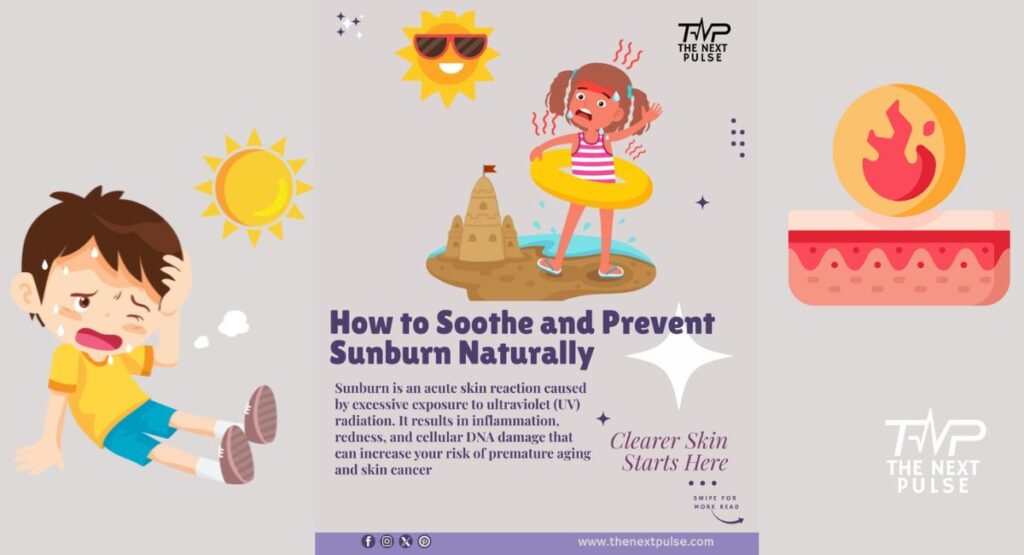
Why You’ll Love This Guide:
- Backed by dermatology expertise and clinical science
- Covers fast-acting solutions and long-term prevention
- Easy-to-follow tips and natural home treatments
Let’s dive in.
What Is Sunburn?
Problem Breakdown
Definition:
Sunburn is an acute skin reaction caused by excessive exposure to ultraviolet (UV) radiation. It results in inflammation, redness, and cellular DNA damage that can increase your risk of premature aging and skin cancer.
What It Looks and Feels Like:
- Color: Red, pink, or purple (varies by skin tone)
- Texture: Tight, hot, dry, possibly swollen
- Symptoms: Burning, peeling, itching, tenderness, sometimes chills or fever
Common Triggers:
Skipping sunscreen or inadequate SPF
Prolonged midday sun exposure (10 AM – 4 PM)
Reflective surfaces like water, sand, or snow
Certain medications (e.g., isotretinoin, antibiotics)
Genetics (fair skin, light eyes, family history of skin cancer)
Sunburn isn’t only about the surface redness—it’s deeper damage to skin cells that your body works to repair. This explains why peeling, tenderness, and prolonged sensitivity often follow.
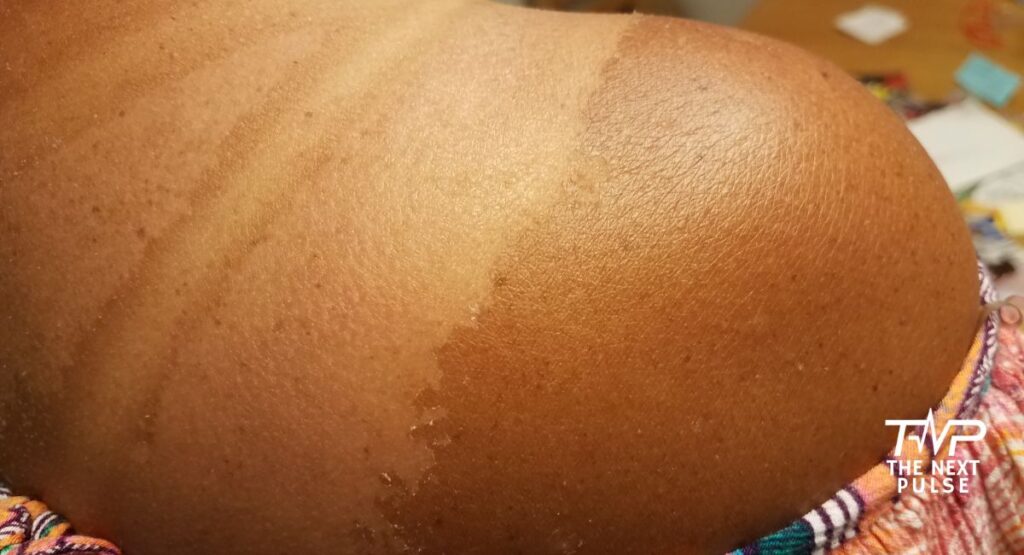
Medical Solutions Dermatologist-Recommended Treatments
Topical Hydrocortisone Cream (1%)
- Reduces redness, swelling, and itching
- Use 2–3x daily for 2–4 days
- Avoid open or blistered skin
NSAIDs (e.g., Ibuprofen or Aspirin)
- Combat internal inflammation and pain
- Take with food and water to avoid stomach irritation
Aloe Vera-Based Moisturizers
- Soothe and hydrate inflamed skin
- Choose alcohol-free gels or creams for best results
Prescription Silver Sulfadiazine
- Used for severe burns with blistering
- Antibacterial and speeds up wound healing
Cool Water Compresses
- Reduce temperature and discomfort
- Apply 15–20 minutes, several times a day
Precautions:
- Avoid further sun exposure until skin is fully healed
- Don’t peel or scrub sunburned skin
- Seek medical help if blisters cover a large area or if symptoms include fever or nausea
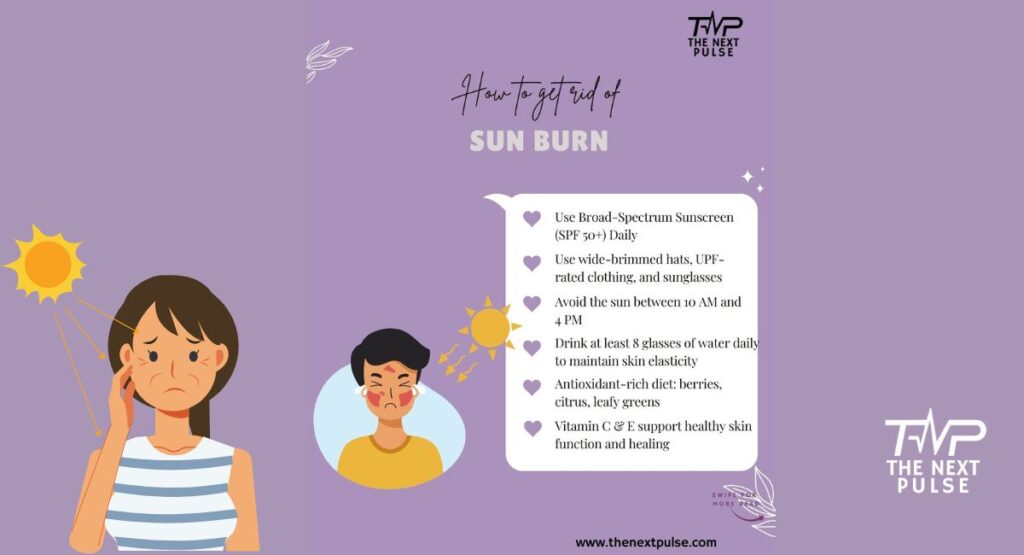
Home Remedies Natural, Science-Backed Soothers
Pure Aloe Vera Gel
- Reduces inflammation and speeds healing
- Apply 2–4x daily for mild burns
- Recovery: 2–5 days
Cold Milk Compress
- Soothes skin with proteins and lactic acid
- Soak cloth in chilled milk and apply for 10–15 minutes
- Best for: Sensitive or blister-prone skin
Oatmeal Baths
- Relieve itching and calm irritation
- Blend 1 cup oats into lukewarm bath, soak 20 minutes
Green Tea Pads
- Antioxidants reduce inflammation
- Chill brewed green tea, soak pads, apply for 10 minutes
Coconut Oil (After Initial Healing Phase)
- Restores moisture and prevents peeling
- Only use once heat and redness have subsided
- Get it here: Coconut oil .
These home remedies not only speed recovery but also give comfort when your skin feels raw and tight. Consistency is key—gentle, frequent care works best.
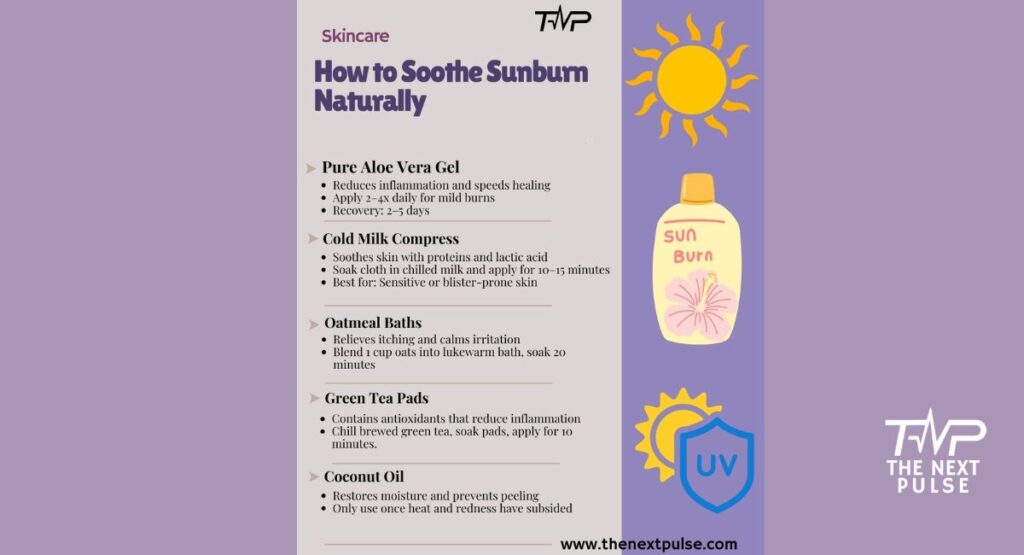
Additional Tips Preventing Future Sunburn
Always Wear Broad-Spectrum Sunscreen (SPF 30+)
- Reapply every 2 hours or after swimming/sweating
Protective Clothing & Accessories
- Use wide-brimmed hats, UPF-rated clothing, and sunglasses
Time Your Sun Exposure
- Avoid the sun between 10 AM and 4 PM
Stay Hydrated
- Drink at least 8 glasses of water daily to maintain skin elasticity
Boost Skin Defense with Diet
- Eat antioxidant-rich foods: tomatoes, berries, leafy greens, green tea
🔧 Pro Tip:
“Even one blistering sunburn in childhood doubles the risk of developing melanoma later in life. Prevention should be as routine as brushing your teeth.” — Dr. Neha Qureshi, MD, FAAD
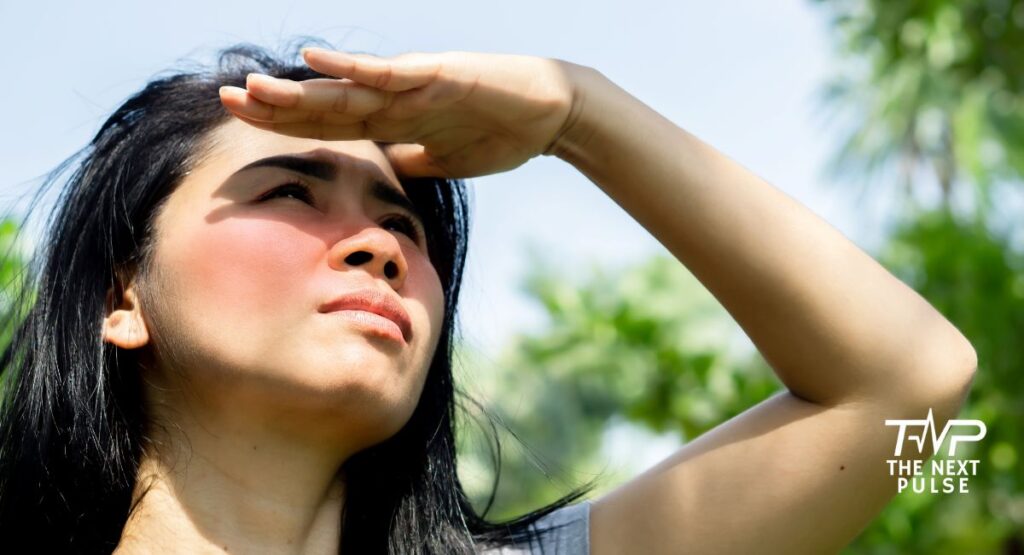
FAQs
1. Can darker skin tones get sunburned?
Yes. While melanin offers some protection, it does not prevent UV damage entirely.
2. Is peeling a sign of healing?
Yes, but it’s also a sign of skin damage. Never force peeling; moisturize instead.
3. Can I tan over a sunburn?
No. Tanning further damages already compromised skin and delays healing.
4. What if I have sunburn and chills?
You may be experiencing sun poisoning. Seek medical care immediately.
5. How long does sunburn last?
Mild cases: 3–5 days; moderate: 7–10 days. Severe burns may take 2+ weeks.
Lifestyle Adjustments to Support Healing
Beyond creams and compresses, your daily habits affect how fast your skin recovers.
- Sleep well. Your body repairs damaged cells during rest. Aim for 7–9 hours nightly.
- Avoid hot showers. Stick to cool or lukewarm water to avoid further irritation.
- Skip harsh skincare. Put exfoliants, retinol, and acids on pause until skin fully heals.
- Stay indoors when possible. Even indirect sunlight can worsen the burn.
Final Thoughts
Sunburn is your skin’s way of saying, “I’ve had enough.” While the damage is real, the recovery doesn’t have to be miserable. With a mix of medical-grade treatments and natural soothers, you can fast-track healing and minimize long-term effects.
Take care of your skin today so it takes care of you tomorrow. And remember: your best skincare product is prevention.
If you experience recurring or severe sunburns, consult a board-certified dermatologist.
- Related Guide: Treat Stubborn Hyperpigmentation Naturally
- Related Guide: Control Oily Skin and Shrink Large Pores Naturally
- Related Guide: Say Goodbye to Dandruff: Proven Natural Remedies
